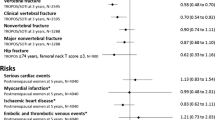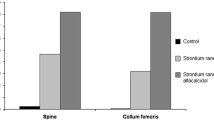Abstract
Strontium ranelate is a new agent developed for the management of post-menopausal osteoporosis. It has a unique mode of action, based on an uncoupling between bone formation (increased) and bone resorption (decreased). To review its effectiveness we searched the MEDLINE database from 1985 to 2008, as well as databases such as the Cochrane controlled register, for citations or relevant articles. After this extensive search of the literature, a critical appraisal of the data was obtained through a consensus meeting (AN, MH, SS, OB, and J-YR). We found that strontium ranelate reduces vertebral, nonvertebral, major nonvertebral, and hip fractures over 1, 3, 4, and 5 years. Its spectrum of activity covers women with osteopenia, osteoporosis, and severe osteoporosis. Elderly subjects also show a reduction in vertebral and nonvertebral fractures. Bone mineral density may be used as a monitoring tool for strontium ranelate, since early changes are predictive of long-term fracture reduction. Biochemical markers of bone turnover reflect the uncoupling between resorption and formation. The safety profile of strontium ranelate compares favorably with the other currently marketed antiosteoporosis medications. Preliminary results suggest that strontium ranelate is able to reduce the progression of spine osteoarthritis. In conclusion, strontium ranelate has the potential to be a candidate for first-line treatment of osteopenia and osteoporosis. However, further research is needed before suggesting its widespread use in osteoarthritis.
Similar content being viewed by others
References
Cooper C, Westlake S, Harvey N, et al. Review: developmental origins of osteoporotic fracture. Osteoporos Int. 2006;17:337–347.
Russell RGG. Pathogenesis of osteoporosis. In: Hochberg MC, Siman AJ, Smolen SJ, Weinblatt ME, Weisman MH, eds. Rheumatology. 3rd edition. New York: Mosby; 2003:2075–2147.
Marie PJ, Hott M, Modrowski D, DePollak, et al. An uncoupling agent containing strontium prevents bone loss by depressing bone resorption and maintaining bone formation in estrogen-deficient rats. J Bone Miner Res.1993;8:607–615.
Canalis E, Hott M, Deloffre P, Tsouderos Y, Marie PJ. The divalent strontium salt S12911 enhances bone cell replication and bone formation in vitro. Bone. 1996;18:517–523.
Reginster JY, Sarlet N, Lejeune E, Leonori L. Strontium ranelate: a new treatment for postmenopausal osteoporosis with a dual mode of action. Curr Osteoporos Rep. 2005;3:30–34.
Reginster JY. Strontium ranelate in osteoporosis. Curr Pharm Des. 2002;8:1907–1916.
Marie PJ, Ammann P, Boivin G, Rey C. Mechanisms of action and therapeutic potential of strontium in bone. Calcif Tissue Int. 2001;69:121–129.
Boivin G, Deloffre P, Perrat B, et al. Strontium distribution and interactions with bone mineral in monkey iliarc bone after strontium salt (S12911) administration. J Bone Miner Res. 1996;11:1302–1311.
Atkins GJ, Welldon KJ, Halbout P, Findlay DM. Strontium ranelate treatment of human primary osteoblasts promotes an osteocyte-like phenotype while eliciting and osteoprotegerin response. Osteoporos Int. 2008. In press.
Kendler D. Strontium ranelate - data on vertebral and nonvertebral fracture efficacy and safety: mechanism of action. Curr Osteoporos Rep. 2006;4:34–39.
Morohashi T, Sano T, Harai K, Yamada S. Effects of strontium on calcium metabolism in rats — II. Strontium prevents the increased rate of bone turnover in ovariectomized rats. Jpn J Pharmacol. 1995;68:153–159.
Marie P. Strontium ranelate: a physiological approach for optimizing bone formation and resorption. Bone. 2006;38(suppl. 1):S10–S14.
Ammann P. Strontium ranelate: a physiological approach for an improved bone quality. Bone. 2006;38(suppl. 1):S15–S18.
Reginster JY, Deroisy R, Dougados M, Jupsin I, Colette J, Roux C. Prevention of early postmenopausal bone loss by strontium ranelate: a randomized, two-year, doubleblind, dose-ranging, placebo-controlled trial. Osteoporos Int. 2002;13:925–931.
Meunier PJ, Slosman DO, Delmas PD, et al. Strontium ranelate: dose-dependent effects in established postmenopausal vertebral osteoporosis: a 2-year randomized placebo controlled trial. J Clin Endocrinol Metab. 2002;87:2060–2066.
Boivin G, Foos E, Tupinon-Mathieu I, Meunier PJ. Strontium deposition in bone is dose dependent and does not alter the degree of mineralization of bone in osteoporotic patients treated with strontium ranelate. J Bone Miner Res. 2000;15(suppl. 1):305.
Meunier PJ, Roux C, Seeman E, et al. The effect of strontium ranelate on the risk of vertebral fracture in women with post menopausal osteoporosis. N Engl J Med. 2004;350:459–468.
Reginster JY, Seeman E, De Vernejoul MC, et al. Strontium ranelate reduces the risk of nonvertebral fractures in postmenopausal women with osteoporosis: treatment of peripheral osteoporosis (TROPOS) study. J Clin Endocrinol Metab. 2005;90:2816–2822.
Reginster JY, Felsenberg D, Boonen S, et al. Effects of long-term strontium ranelate on the risk of nonvertebral and vertebral fractures in postmenopausal osteoporosis. Arthritis Rheum. 2008;58:1687–1695.
Meunier PJ, Reginster JY. Design and methodology of the phase 3 trials for the clinical development of strontium ranelate in the treatment of women with postmenopausal osteoporosis. Osteoporos Int. 2003;14 (suppl. 3): 66–76.
Reginster JY, Spector T, Badurski J, et al. A short-term run-in study can significantly contribute to increasing the quality of long-term osteoporosis trials. The strontium ranelate phase III program. Osteoporos Int. 2002;13(suppl. 1):S30.
Genant HK, Wu CY, Van Kuijk C, Nevitt MC. Vertebral fracture assessment using a semiquantitative technique. J Bone Miner Res. 1993;8:1137–1148.
Meunier PJ, Roux C, Ortolani S, et al. Strontium ranelate reduces the vertebral fracture risk in women with postmenopausal osteoporosis. Osteoporos Int. 2002;13(suppl. 1):O45.
Roux C, Reginster JY, Fechtenbaum J, et al. Vertebral fracture risk reduction with strontium ranelate in women with postmenopausal osteoporosis is independent of baseline risk factors. J Bone Miner Res. 2006;21:536–542.
Naves M, Diaz Lopez JB, Gomez C, Rodriguez Rebollar A, Rodriguez Garcia M, Cannata Andia JB. The effect of vertebral fracture as a risk factor for osteoporotic fracture and mortality in a Spanish population. Osteoporos Int. 2003;14:520–524.
van Staa TP, Leufkens HGM, Cooper C. Does a fracture at one site predict later fractures at other sites? A British cohort study. Osteoporos Int. 2002;13:624–629.
Roux C, Fechtenbaum J, Kolta S, Isaia G, Cannata Andia JB, Devogelaer JP. Strontium ranelate reduces the risk of vertebral fracture in young postmenopausal women with severe osteoporosis. Ann Rheum Dis. 2008;67:1736–1738.
Population Division of the Department of Economic and Social Affairs of the Nations Secretariat 2002. World population prospects: the 2002 revision and world urban prospects. Available at: www.esa.un.org. Accessed October 1, 2008.
Ettinger MP. Aging bone and osteoporosis: strategies for preventing fractures in the elderly. Arch Intern Med. 2003;163:2237–2246.
McClung MR, Geusens P, Miller PD, et al. Effect of risedronate on the risk of hip fracture in elderly women. Hip intervention program study group. N Engl J Med. 2001;344:333–340.
Seeman E, Vellas B, Benhamou C, et al. Strontium ranelate reduces the risk of vertebral and nonvertebral fractures in women eighty years of age and older. J Bone Miner Res. 2006;21:1113–1120.
S eeman E, Devogelaer J, Lorenc R, et al. Strontium ranelate reduces the risk of vertebral fractures in patients with osteopenia. J Bone Miner Res. 2008;23:433–438.
Malaise O, Bruyere O, Reginster JY. Strontium ranelate normalizes bone mineral density in osteopenic patients. Aging Clin Exp Res. 2007;19:330–333.
Reginster JY, Meunier PJ. Strontium ranelate phase 2 dose-ranging studies: PREVOS and STRATOS studies. Osteoporos Int. 2003;14:S56–S65.
Bruyere O, Roux C, Detilleux J, et al. Relationship between bone mineral density changes and fracture risk reduction in patients treated with strontium ranelate. J Clin Endocrinol Metab. 2007;92:3076–3081.
Bruyere O, Roux C, Badurski J, et al. Relationship between change in femoral neck bone mineral density and hip fracture incidence during treatment with strontium ranelate. Curr Med Res Opin. 2007;23:3041–3045.
Arlot ME, Jiang Y, Genant HK, et al. Histomorphometric and μ-CT analysis of bone biopsies from postmenopausal osteoporotic women treated with strontium ranelate. J Bone Miner Res. 2008;23:215–222.
de la Loge C, Sullivan K, Pinkney R, Marquis P, Roux C, Meunier PJ. Crosscultural validation and analysis of responsiveness of the QUALIOST®: QUAlity of Life questionnaire In OSTeoporosis. Health Qual Life Outcomes. 2005;3:69.
Marquis P, de la Loge C, Diaz-Curiel M, Spector T, Meunier PJ. Beneficial effects of strontium ranelate on the quality of life in patients with vertebral osteoporosis (SOTI study). Osteoporos Int. 2005;16:S54
Lawrence RC, Helmick CG, Arnett FC, et al. Estimates of the prevalence of arthritis and selected musculoskeletal disorders in the United States. Arthritis Rheum. 1998;41:778–799.
Recommendations for the registration of drugs used in the treatment of osteoarthritis. Group for the Respect of Ethics and Excellence in Science (GREES): osteoarthritis section. Ann Rheum Dis. 1996;55:552–557.
Altman R, Brandt K, Hochberg M, et al. Design and conduct of clinical trials in patients with osteoarthritis: recommendations from a task force of the Osteoarthritis Research Society. Results from a workshop. Osteoarthritis Cartilage. 1996;4:217–243.
Dougados M, Nguyen M, Berdah L, Mazieres B, Vignon E, Lequesne M. Evaluation of the structure-modifying effects of diacerein in hip osteoarthritis: ECHODIAH, a three-year, placebo-controlled trial. Evaluation of the chondromodulating effect of diacerein in OA of the hip. Arthritis Rheum. 2001;44:2539–2547.
Reginster JY, Deroisy R, Rovati LC, et al. Long-term effects of glucosamine sulphate on osteoarthritis progression: a randomised, placebo-controlled clinical trial. Lancet. 2001;357:251–256.
Pavelka K, Gatterova J, Olejarova M, Machacek S, Giacovelli G, Rovati LC. Glucosamine sulfate use and delay of progression of knee osteoarthritis: a 3-year, randomized, placebo-controlled, double-blind study. Arch Intern Med. 2002;162:2113–2123.
Michel BA, Stucki G, Frey D, et al. Chondroitins 4 and 6 sulfate in osteoarthritis of the knee: a randomized, controlled trial. Arthritis Rheum. 2005;52:779–786.
Uebelhart D, Malaise M, Marcolongo R, et al. Intermittent treatment of knee osteoarthritis with oral chondroitin sulfate: a one-year, randomized, doubleblind, multicenter study versus placebo. Osteoarthritis Cartilage. 2004;12:269–276.
Brandt KD, Mazzuca SA, Katz BP, et al. Effects of doxycycline on progression of osteoarthritis: results of a randomized, placebo controlled, double-blind trial. Arthritis Rheum. 2005;52:2015–2025.
Neogi T, Nevitt MC, Ensrud KE, Bauer D, Felson DT. The effect of alendronate on progression of spinal osteophytes. Arthritis Rheum. 2006;54(suppl.):S822.
Martel-Pelletier J, Lajeunesse D, Fahmi H, Tardif G, Pelletier JP. New thoughts on the pathophysiology of osteoarthritis: one more step toward new therapeutic targets. Curr Rheumatol Rep. 2006;8:30–36.
Henrotin Y, Labasse A, Zheng SX, et al. Strontium ranelate increases cartilage matrix formation. J Bone Miner Res. 2001;16:299–308.
Alexanderson P, Karsdal M, Qvist P, Reginster JY, Christiansen C. Strontium ranelate reduces the urinary level of cartilage degradation biomarker CTX-II in postmenopausal women. Bone. 2007;40:218–222.
Bruyere O, Delferriere D, Roux C, et al. Effects of strontium ranelate on spinal osteoarthritis progression. Ann Rheum Dis. 2008;67;335–339.
Lane NE, Nevitt MC, Genant HK, Hochberg MC. Reliability of new indices of radiographic osteoarthritis of the hand and hip and lumbar disc degeneration. J Rheumatol. 1993;20:1911–1918.
Grosso A, Douglas I, Hingorani A, MacAllister R, Smeeth L. Post-marketing assessment of the safety of strontium ranelate; a novel case-only approach to the early detection of adverse drug reactions. Br J Clin Pharmacol. 2008;66:689–694.
Shea B, Wells G, Cranney A, et al. Osteoporosis Methodology Group; Osteoporosis Research Advisory Group. Calcium supplementation on bone loss in postmenopausal women. Cochrane Database Syst Rev. 2004;(1):CD004526.
Question and answers on the safety of Protelos/Osseor (strontium ranelate). London: European Medicines Agency; 2007. Ref. EMEA/534613/2007. Available at: www.emea.europa.eu/humandocs/PDFs/EPAR/protelos/Protelos_Q&A_53461307en.pdf. Accessed October 1, 2008.
Tas S, Simonart T. Management of drug rash with eosinophilia and systemic symptoms (DRESS syndrome): an update. Dermatology. 2003;206:353–356.
Author information
Authors and Affiliations
Corresponding author
Rights and permissions
About this article
Cite this article
Neuprez, A., Hiligsmann, M., Scholtissen, S. et al. Strontium ranelate: The first agent of a new therapeutic class in osteoporosis. Adv Therapy 25, 1235–1256 (2008). https://doi.org/10.1007/s12325-008-0125-8
Published:
Issue Date:
DOI: https://doi.org/10.1007/s12325-008-0125-8




